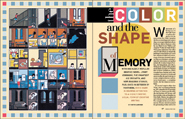Poets & Writers Magazine welcomes letters from its readers. Please post a comment on select articles at www.pw.org/magazine, e-mail editor@pw.org, or write to Editor, Poets & Writers Magazine, 90 Broad Street, Suite 2100, New York, NY 10004. Letters accepted for publication may be edited for clarity and length.
GETTING GRAPHIC As a writer and graphic collaborator, I’ve followed the slow acclimation of cartoonists to the literary canon. Chris Ware (“The Color and the Shape of Memory” by Kevin Larimer, November/
December 2012) is a master at minute storytelling. This isn’t narrative composed for pods or tablets. Ware’s is a concise and expansive evolution from cave paintings, comic strips, fine art, and the kind of flotsam wonderment that is both “graphic” and “novel.” In my own work, I am drawn to singular and sequential poetic moments that highlight each image. Chris Ware has linked thresholds—toward things, not ideas: the “ordinary made extraordinary by your attention to it,” as Allen Ginsberg liked to say. Ware’s work forces readers to hone and relate, from image to image, pushing awareness through time as blocks of content fit what appear to be alternative and elusive functions and form.
As a writer and graphic collaborator, I’ve followed the slow acclimation of cartoonists to the literary canon. Chris Ware (“The Color and the Shape of Memory” by Kevin Larimer, November/
December 2012) is a master at minute storytelling. This isn’t narrative composed for pods or tablets. Ware’s is a concise and expansive evolution from cave paintings, comic strips, fine art, and the kind of flotsam wonderment that is both “graphic” and “novel.” In my own work, I am drawn to singular and sequential poetic moments that highlight each image. Chris Ware has linked thresholds—toward things, not ideas: the “ordinary made extraordinary by your attention to it,” as Allen Ginsberg liked to say. Ware’s work forces readers to hone and relate, from image to image, pushing awareness through time as blocks of content fit what appear to be alternative and elusive functions and form.
Peter Money
Brownsville, Vermont
CELEBRATING HOPKINS
I thoroughly embraced “The Art of Reading Gerard Manley Hopkins: Austerity Made Sublime” by William Giraldi (November/December 2012). I share Hopkins’s denunciation of “populist poetry” as “treat[ing] people like fools” and appreciate Giraldi’s observation that “the major poet writes into the density of language while the minor one merely floats on top of it.” Giraldi’s critique of popular fiction as “a morass of cliché without vigor or revelation, abrupt sentences that have arrived on the page without a commitment to the dynamism and dimensions of language” is unforgiving but accurate. Thankfully there remain poets and novelists who believe that the beauty and complexity of the English language have yet to be discovered and fashioned, that unforgettable images matter, that vivid characterization and narrative create intrinsic resonance, and that meaning can transform our lives.
Tom Ukinski
Lincoln, Nebraska
I enjoyed Giraldi’s essay, but when he calls Hopkins one of “the two most austere wordsmiths in our tongue,” I have to wonder whether the term austere has changed meaning over the years. The author of “The Windhover,” “God’s Grandeur,” and “Pied Beauty” is exuberant and all over the place. Restricting Hopkins mainly to the “Terrible Sonnets” is a distortion or, at most, a limited view—and even then, the mood may be depressing, but the language is still rich and resonant, not strict or Spartan.
David Galef
Montclair, New Jersey
BIBLICAL PROPORATIONS
As a theologian I was amazed to find that in “The Aha! Moment: Michael Wiegers of Copper Canyon Press” (November/December 2012), Michael Bourne accepted Wiegers’s claim that Mary Magdalene was a “prostitute, or concubine.” There is nothing of this sort in the New Testament, which places her among the disciples who remained with Jesus at his crucifixion. The characterization of her as a prostitute began only with Pope Gregory the Great’s assertion in the late sixth century that she was the same “sinful woman” who, in the Gospel according to Luke, anointed Jesus’s feet. Since then, she has become a practical Rorschach blot for people’s religious and erotic imaginations, most recently in Dan Brown’s thrillers. While writers of poetry and fiction may want to continue these claims for their own artistic purposes, for a reputable editor or journalist to pass this error off without comment, along with its implied delegitimization of women’s roles in the early Church, is most unfortunate.
William Johnson Everett
Waynesville, North Carolina






